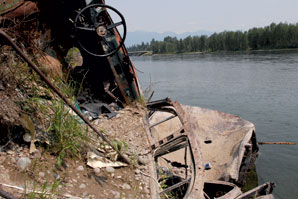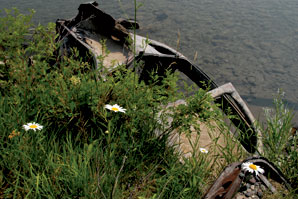Kalispell resident Mike Evans was walking along the Flathead River on one of his favorite trails when he saw something he had never noticed before. Jutting from the riverbank was part of a rusted car. Down the trail, he ran into another car, and then several more.
What Evans saw were relics from a 1950s erosion control experiment, when cars were taken from wrecking yards and dumped into the river to, hopefully, stabilize the eroding bank. For a period, the method was widely used along the Flathead River and other streams across the state and nation.
Today, there are rusted cars scattered along the banks and bottoms of rivers throughout Montana and beyond, remnants of a time when rivers were less regulated and self-reliant people were trying to figure out how to battle the escalating problem of erosion.
 |
|
The bodies of old cars spill from the eroded banks of the Flathead River into the water near the Old Steel Bridge fishing access east of Kalispell. |
“Wow, I’ll tell you, there’s some chrome down there,” Evans said, gesturing to a line of cars partially embedded in the earth and partially submerged in the water.
Clifford Brenneman, 79, knows where at least a few of the cars came from. He was in his early 20s when he helped his father place gutted cars along the riverbanks where their farmland bordered the Flathead River.
The Brennemans were among the many Flathead landowners in the early 1950s experimenting with the “Detroit Riprap” method of erosion control. Kalispell Wrecker, Brenneman said, was busy during those years, gutting and loading cars in preparation for an eventual destination in the Flathead River.
On occasion, Brenneman said the cars, after having their engines and other innards removed by cutting torches, would send sparks shooting off the back of his flatbed as he hauled the cars down city streets.
“You could see sparks in the mirror,” Brenneman said. “You thought, ‘Well, I better get out there quick.’”
Once in the water, if the cars held, they became a sturdy part of the bank, resisting the river’s strength in ways soil couldn’t. If they didn’t hold, they became an odd sight, drifting down the river like some metal Montana hippo.
“It’s something we did and we thought it was good,” Brenneman said. “But we found out later it wasn’t very wise. Sometimes we have better hindsight than foresight.”
The rusting auto bodies are part of the everyday sightseeing experience for floaters on the Flathead River and other streams. Some are fully exposed, while others only have parts protruding from the earth.
Over time, Brenneman said the river deposited sand and soil on top of the embedded auto bodies, even fully burying some. Similarly, the river’s shifting waters can just as completely unearth the cars after they’ve been buried.
“If it can wash it in,” he said, “it can wash it out.”
Interestingly, nearly 60 years after Clifford Brenneman helped his father unload cars into the Flathead River, Brenneman’s son, Joe, has helped form a commission aimed at pursuing river stabilization methods.
Joe Brenneman, a Flathead County commissioner, helped form the Flathead County River Commission to address issues associated with living near the water, such as pollutants, erosion and farming procedures.
The commission consists of landowners along the Flathead River, a representative from Montana Fish, Wildlife and Parks, a representative from the Flathead Conservation District and a county commissioner. It received a grant from the Department of Environmental Quality to explore different approaches to riverbank stabilization.
An environmental consulting company out of Missoula has helped the river commission as it tries to narrow down the best river stabilization approaches, Joe Brenneman said.
The Flathead River has unique erosion dilemmas because Flathead Lake’s water levels are controlled, affecting the water’s behavior upstream, particularly in the 20 to 30 miles directly above the lake. It’s not unusual for landowners to watch chunks of their land get carried away by the river.
 |
|
Flowers grow along the bank of the Flathead River above the body of an old car recently exposed by erosion. |
Rusby Seabaugh, who owns land along the river 22 miles upstream from Flathead Lake, said the stretch of river along his land is essentially an extension of the lake. During the summer, its water level is high, in accordance with the lake’s level. In the winter and spring, it drops by 10-14 feet, exposing bare banks with no vegetation that are vulnerable to erosion.
The river eats away at the bank and carries potentially harmful nutrients and pollutants into Flathead Lake.
“The problem is that if we don’t do anything, it vastly affects the water quality of Flathead Lake,” Seabaugh said.
Seabaugh is a member of Flathead County River Commission and said the commission was initially formed to address the lower river’s issues, but has since grown to incorporate the whole river. Slumping banks are a constant concern for a landowner like Seabaugh, and the region’s history of flooding only adds to the problem.
Since the 1970s, Seabaugh has been trying to stabilize the banks along his property. And, for the time being, his land is one of the best models for erosion control in the valley, though he concedes that it’s expensive and not a viable option for many.
Seabaugh has used large rocks to stabilize the lower bank where the river makes contact. Above that, he has sloped the bank “so it doesn’t cave in so easily,” and planted vegetation on top. The trees and shrubs hold the banks in place with their root structures and “look a little better than straight rock cliffs.”
“Most of the people who are doing projects up and down the river are doing some form of that,” Seabaugh said.
But Seabaugh didn’t use that method on all of his riverfront property. About a quarter-mile of it is stabilized by cars, which had already been there for more than two decades when he bought his property in the 1970s.
“They worked well, but if the erosion gets behind them and the car bodies get exposed, then you have problems,” Seabaugh said. “But you have to leave them alone; if you took them out, that would really cause problems for the bank.”
Seabaugh said he had heard that the U.S. Army Corps of Engineers placed the cars there. Nola Leyde, spokesperson for the Corps, said she couldn’t find specific evidence to verify that her agency used junk cars in projects on the Flathead River, but added: “It was a very common practice in the 1950s.”
Part of the river commission’s goal, Seabaugh said, is to make stabilization possible for more landowners, by finding a cheaper alternative and by tweaking the permitting process required to work on a stream.
“It’s getting harder to do things on the river; the permitting process is getting harder,” he said. “It needs some help and we’d like to streamline it some if possible.”
As for the rusted cars, if they don’t seem to be serving a purpose, Joe Brenneman said people can have them removed by calling the solid waste district. Everybody, Brenneman said, pays a junk vehicle tax when they register their cars, which funds the removal of abandoned cars. But, if the car is in the river, a special permit will likely be required, he said.
“They’re a hazard to boats and swimmers,” Brenneman said. “We come across car bodies in the strangest places, everywhere. The rivers are so dynamic.”